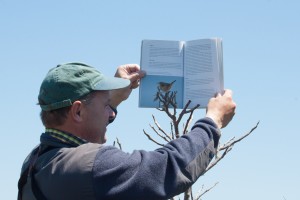Two weeks ago I wrote about the dearth of spring migrants in New Hampshire due to a stationary weather system that dominated the region in early May. It blocked birds’ northward progress out of the Gulf States until the system dissipated on May 9th, and immediately thereafter a wave of new arrivals appeared. I led several trips to Star Island off the coast of New Hampshire through this period, during which I witnessed the effects of changing weather on bird movement. From slow beginnings, the conditions toward the end of the month turned favorable and resulted in a classic fallout of migrants along the coast of New England for several days beginning May 21st.
Warblers are the yardstick by which spring migration is measured. They are a large group of long distance migrants – more than 25 species can be seen in New Hampshire in spring. On any given day in mid-May, I would expect to see more than a dozen species on the island, yet on May 12, our group recorded only nine species numbering fewer than 20 individuals. The 29 warblers of thirteen species that were tallied on May 18th still represented a low return for the location and time of year, but things changed soon thereafter. Beginning May 21st, a southerly airflow brought birds into the region in numbers, and a series of fronts moved through New England bringing heavy cloud cover and precipitation, conditions that brought migrants to ground. A repeat visit to Star on May 27th was on the tail end of the fallout, yet our group recorded almost 100 individuals of 16 species. Only two, Yellow Warbler and Common Yellowthroat breed on the island, so it was clear that most were migrants.
Recording birds by sight is a tricky business and it is difficult to avoid over or undercounting individuals. Appledore Island, the largest of the Isles of Shoals and Star Island’s near neighbor to the north provides a better yardstick for measuring bird abundance. The island has hosted a bird banding laboratory since the 1970’s, during which time more than 100,000 birds have been banded. By definition the process eliminates the problem of over or undercounting – birds counted are banded with uniquely numbered aluminum leg bands, thus preventing duplication. In addition, the relative abundance of birds can be calculated as a function of banding effort, which is the number of mist nets times the number of hours. Appledore’s crew banded an average of 123 birds in the ten days to May 20th. From May 21 to 23 they banded 390, 208, and 276 birds respectively, a number that reflects the intensity of the fallout that we witnessed on nearby Star Island.
The phenomenon was evident inland also, though not to the same degree as on the coast. In addition to warblers and other land birds, many shorebirds were brought to ground by the weather. May is an exciting time to be out and about and ranks as perhaps the best month of the year for birding, followed closely by September and October. With a couple of exceptions, I will be putting the binoculars away until then so I can get some much needed chores done. Check back for information on fall trips to Star.

No comments yet.